Choosing the right running shoe is crucial for achieving optimal performance and comfort during your runs.
In this blog post, we will compare two popular running shoes: the Brooks Cascadia 16 and the Catamount 2.
Both shoes offer unique features and technologies designed to enhance your running experience.
By understanding their key characteristics, you can make an informed decision on which shoe suits your needs best.
Below is a deep technical side-by-side comparison table for the Brooks Cascadia 16 and the Catamount 2 running shoes:
| Features | Brooks Cascadia 16 | Catamount 2 |
| Weight | Lightweight (297.7g) | Lightweight (275.0g) |
| Cushioning | Responsive, cushioned | Responsive, cushioned |
| Pronation Support | Neutral | Stability for overpronators |
| Upper Material | Mesh, synthetic overlays | Lightweight mesh, TPU overlays |
| Midsole Technology | BioMoGo DNA midsole, Pivot Post System | DNA FLASH midsole, Rocker Geomotry |
| Outsole Technology | TrailTack rubber outsole | Sticky Trail rubber outsole |
| Traction | Excellent grip on various terrains | Excellent grip on various terrains |
| Breathability | Highly breathable | Highly breathable |
| Heel-to-Toe Drop | 8mm | 6mm |
| Arch Support | Medium | Medium |
| Fit | Regular | Regular |
| Toe Box | Roomy | Roomy |
| Durability | Durable construction | Durable construction |
| Terrain | Versatile (trails, gravel, road) | Versatile (trails, gravel, road) |
| Protection | Stone guard, toe cap | Stone guard, toe cap |
| Stability | Good stability on uneven terrain | Excellent stability for overpronators |
| Energy Return | Good energy return | Excellent energy return |
| Flexibility | Flexible sole for natural movement | Flexible sole for natural movement |
| Waterproof | Water-resistant | Water-resistant |
| User Reviews | Positive feedback from neutral pronators | Positive feedback from overpronators and neutrals |
| Price | Mid-range ($99.95) | Mid-range ($170) |
| Check the latest price on Amazon For Men For Women | Check the latest price on Amazon For Men For Women |
You May Also Like – Brooks Cascadia 16 vs Caldera 6: Which Running Shoe is Right for You?
Overview of Brooks Cascadia 16
The Brooks Cascadia 16 is a highly regarded running shoe known for its exceptional comfort and versatility.
With a focus on cushioning and responsiveness, it provides a smooth and enjoyable ride.
The shoe incorporates advanced technologies to enhance performance, such as Brooks’ responsive cushioning system.
The lightweight design and breathability of the Cascadia 16 contribute to its overall performance, making it an excellent choice for various types of runners.
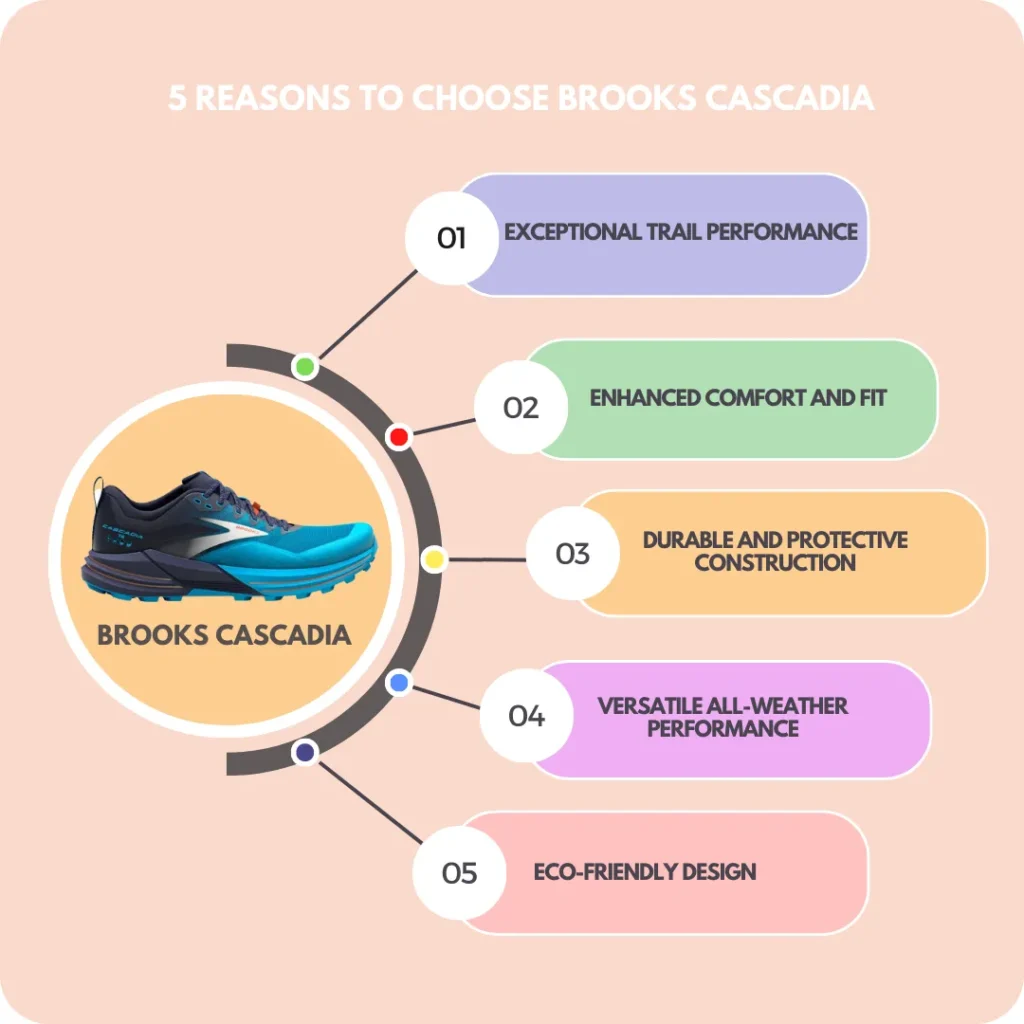
Also Read – Brooks vs Asics: The 7 Key Differences Between Brands
Overview of Catamount 2
The Catamount 2 is a cutting-edge running shoe that builds upon the success of its predecessor.
It boasts several advancements to cater to the needs of runners seeking stability and support.
Overpronators will appreciate the shoe’s design, which offers excellent stability features.
The Catamount 2 also excels in providing cushioning and energy return, ensuring a responsive and efficient running experience.
Durability and traction are other notable qualities, making the shoe a reliable companion for long-lasting performance.
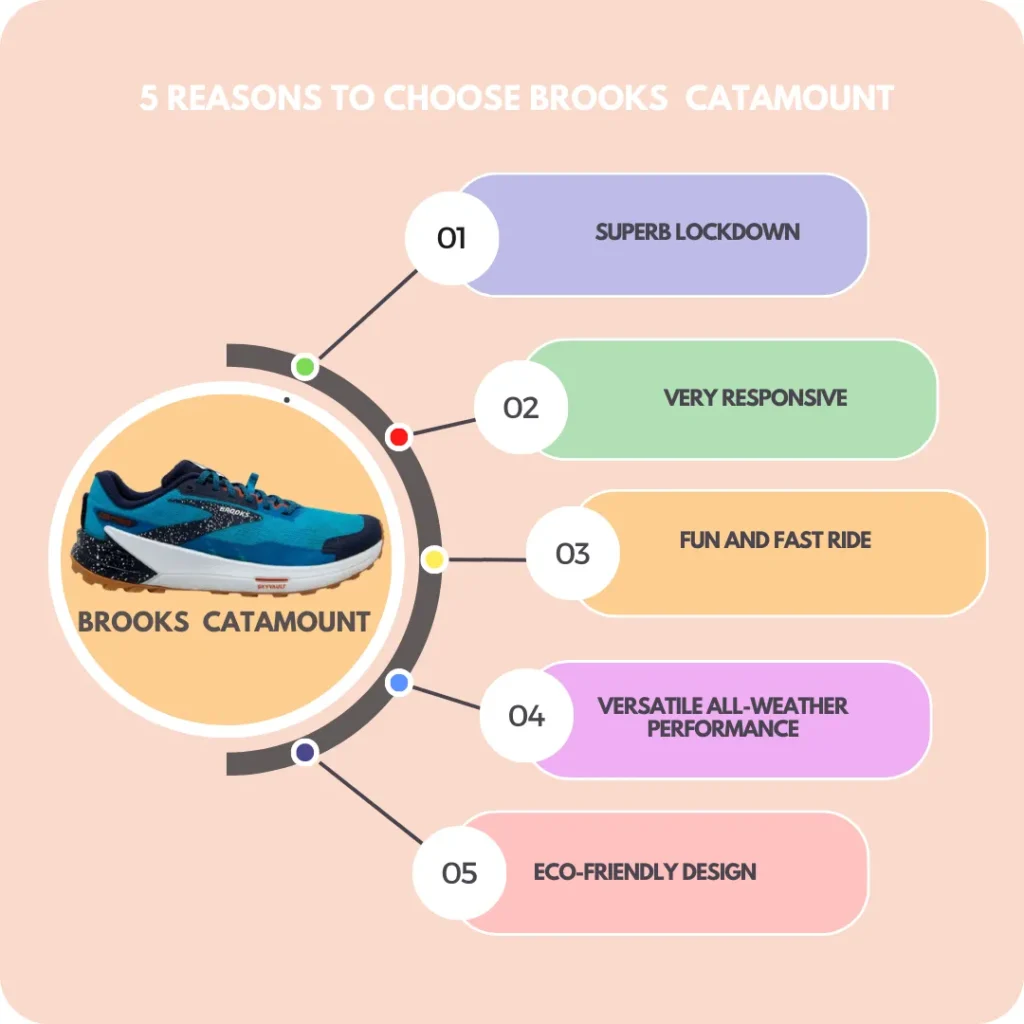
Also Read – Brooks Ghost 15 vs Cascadia 16: Which Running Shoe is Right for You?
Comparison: Cascadia 16 vs Catamount 2
When comparing the Brooks Cascadia 16 and the Catamount 2, it’s essential to examine their design, cushioning, responsiveness, stability, and suitability for different types of runners.
The aesthetic appeal of both shoes may vary, allowing runners to choose a style that aligns with their preferences.
In terms of cushioning and responsiveness, the Cascadia 16 offers exceptional comfort, while the Catamount 2 focuses on energy return and responsiveness.
The stability features of the Cascadia 16 cater to neutral runners, while the Catamount 2 is tailored for overpronators seeking enhanced support.
Detailed information, features, technologies, and performance can be found in the side-by-side comparison chart below this section, enabling readers to make an informed decision.
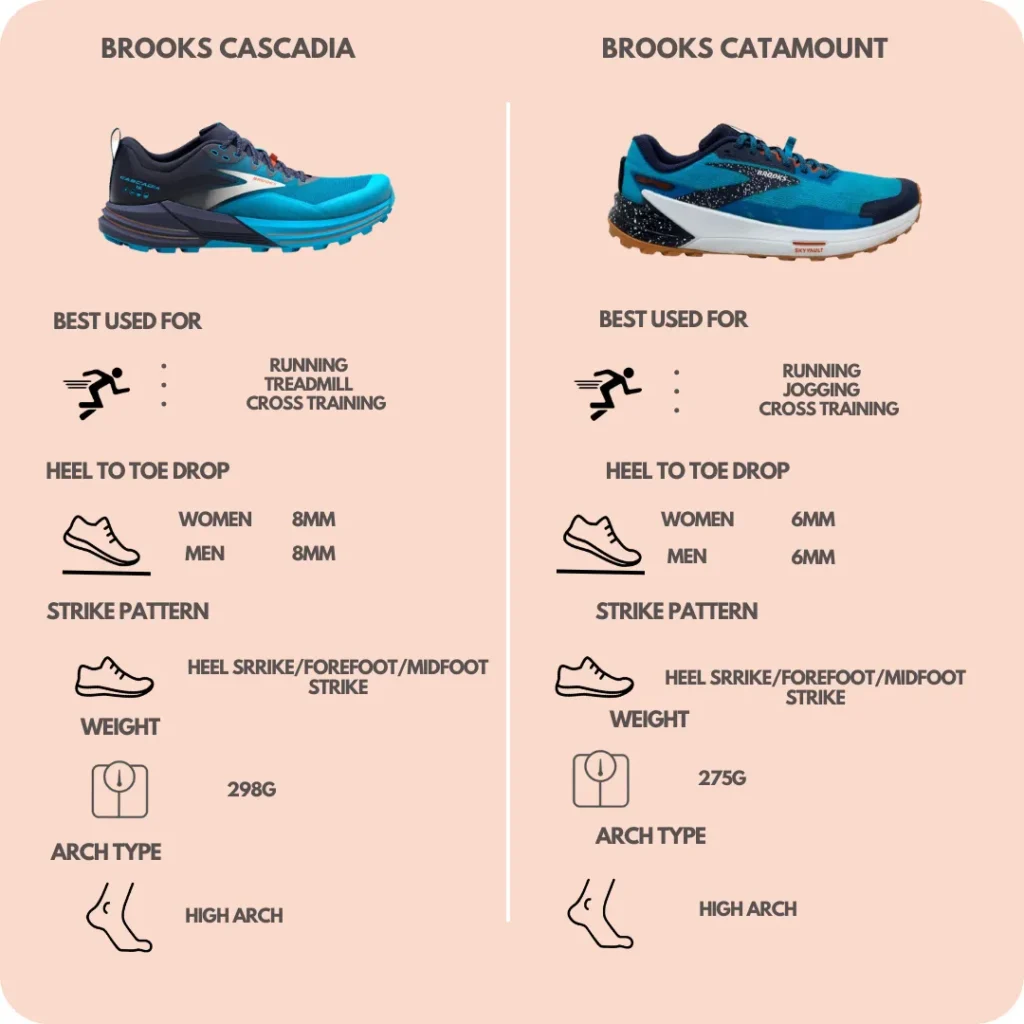
You May Also Like – Brooks Catamount 2 vs Divide 3: Choosing the Perfect Trail Running Shoe
My Personal Experience: Brooks Cascadia 16 and the Catamount 2
As an avid runner, I have had the opportunity to try both the Brooks Cascadia 16 and the Catamount 2 during my training sessions.
Each shoe offers distinct features that cater to different running styles and preferences.
Here’s my personal experience with both models:
When I first laced up the Cascadia 16, I was immediately impressed by its cushioning system.
The shoe provided excellent support and comfort, allowing me to tackle long distances with ease.
The responsiveness of the shoe was remarkable, ensuring a smooth and efficient stride.
I particularly appreciated its lightweight design, as it made me feel agile and nimble on the trails.
The breathability of the Cascadia 16 also prevented my feet from overheating, keeping them cool and dry throughout my runs.
Overall, the Cascadia 16 is a versatile shoe that suits various types of runners, especially those with neutral pronation.
When I switched to Catamount 2, I noticed a significant difference in terms of stability and support.
As an overpronator, I found that the Catamount 2 provided the necessary structure to correct my gait and reduce the risk of injuries.
The cushioning system in the shoe offered an excellent balance of comfort and energy return, making each stride feel powerful and efficient.
The durability and traction of the Catamount 2 were exceptional, allowing me to confidently tackle challenging terrains without any concerns.
While the Catamount 2 is designed with stability in mind, it still offers a comfortable and responsive running experience for neutral runners as well.
Read – Compare Brooks with Other Brand Hoka – Brooks Catamount 2 vs Hoka Tecton X
Which is Best for you?
Choosing between the Brooks Cascadia 16 and the Catamount 2 depends on your running style and specific needs.
If you have neutral pronation and prefer a lightweight and versatile shoe, the Cascadia 16 would be an excellent choice.
Its cushioning, responsiveness, and breathability make it suitable for various terrains and distances.
On the other hand, if you are an overpronator or require additional stability and support, the Catamount 2 would be the better option.
Its stability features, cushioning, and durability are well-suited for those seeking extra support during their runs.
Ultimately, the best shoe for you will depend on your unique foot structure, running style, and personal preferences.
It is recommended to try on both shoes and assess how they feel during a test run.
Consider visiting a local store or seeking professional advice to ensure the perfect fit for your individual needs.
Remember, the right shoe will enhance your running experience, providing you with comfort, support, and improved performance.
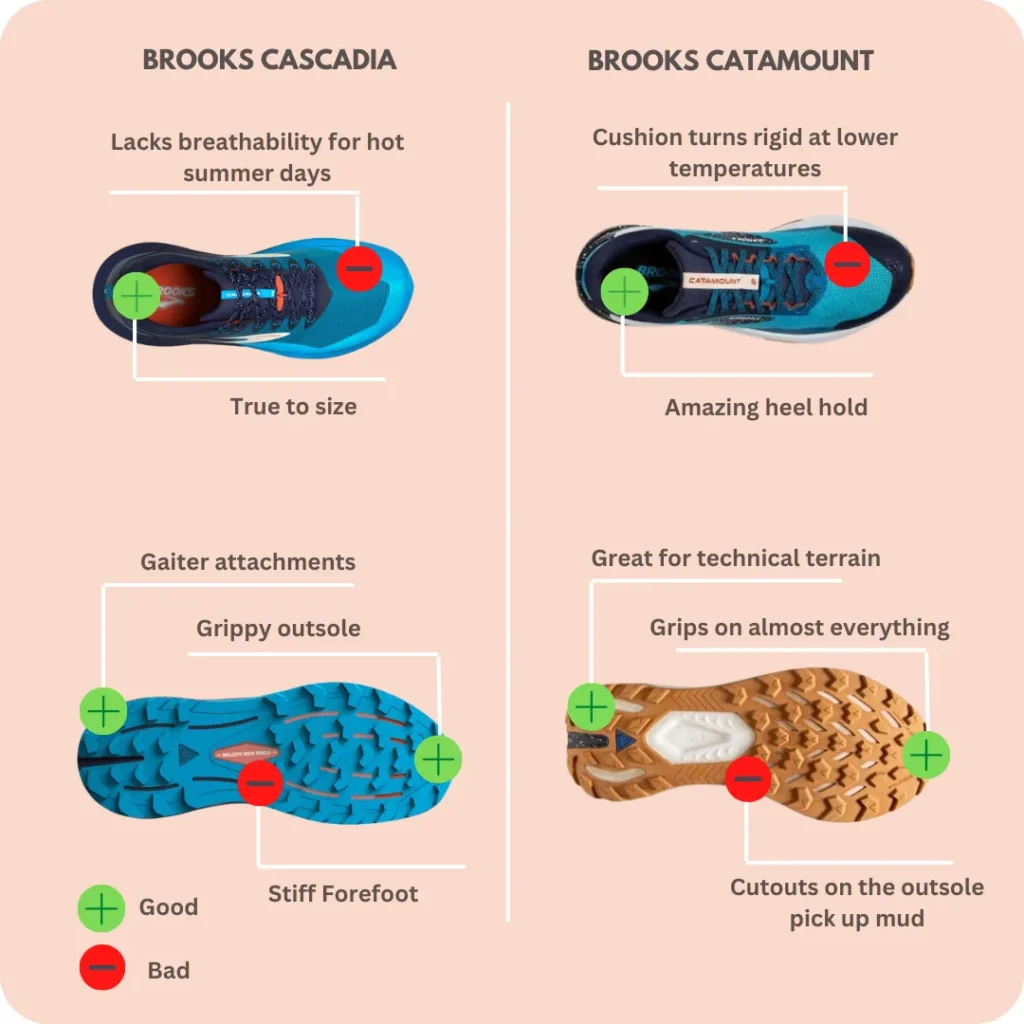
Final Thoughts
Selecting the right running shoe is a personal choice that depends on various factors.
To determine the best fit, it is advisable to try on both the Brooks Cascadia 16 and the Catamount 2.
Consider your running style, foot type, and specific requirements to make an informed decision.
Remember, what works for one runner may not work for another.
In conclusion, the Brooks Cascadia 16 and the Catamount 2 offer exceptional qualities, and by assessing your individual needs, you can choose the perfect running shoe for your journey.
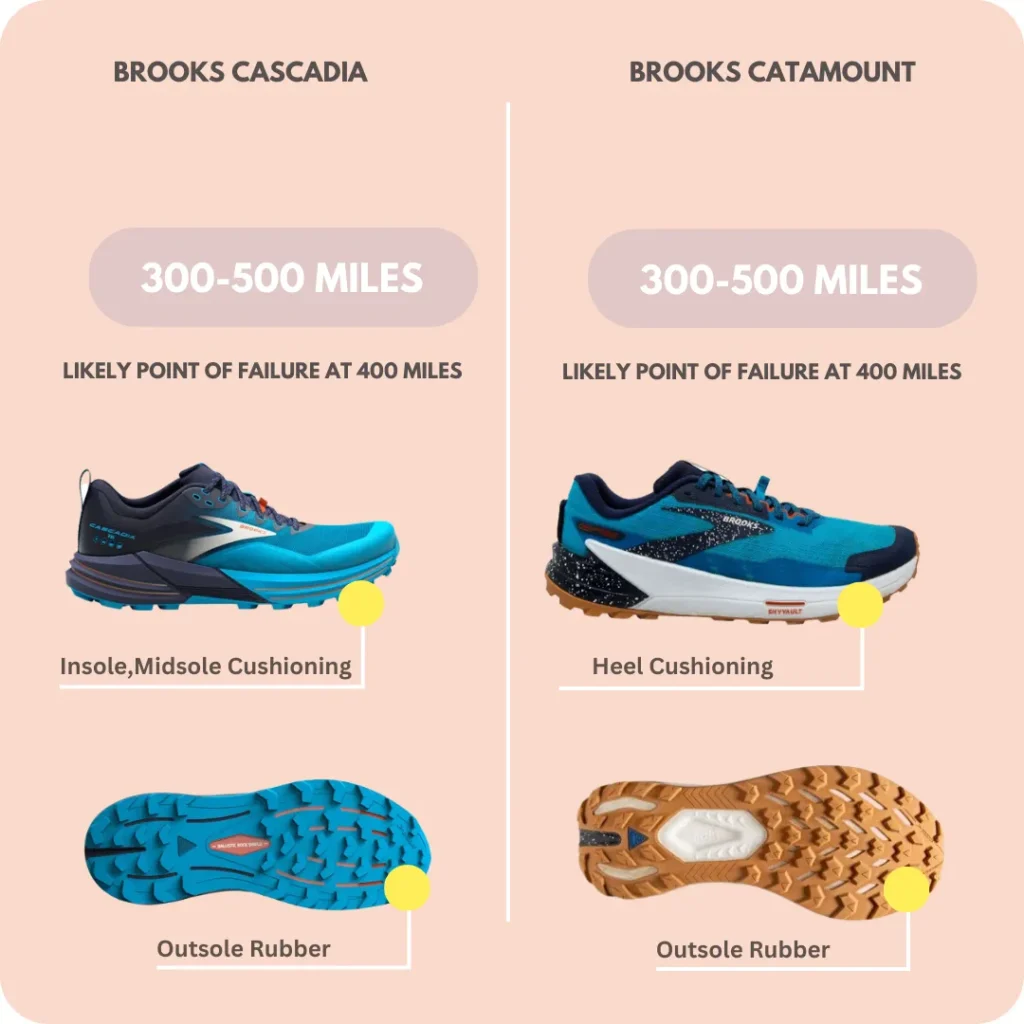
FAQs
How do Brooks Cascadia 16 and Catamount 2 differ from each other?
The Brooks Cascadia 16 and Catamount 2 differ in terms of design, cushioning, stability, support, traction, and pronation support.
Which shoe is best for neutral runners?
Both the Brooks Cascadia 16 and Catamount 2 are suitable for neutral runners. However, the Cascadia 16 is specifically designed for neutral pronation.
Are the Brooks Cascadia 16 and Catamount 2 suitable for overpronators?
The Catamount 2 is designed to provide stability and support for overpronators, while the Cascadia 16 is more suitable for neutral pronators.
How do the cushioning systems of the Cascadia 16 and Catamount 2 compare?
The Brooks Cascadia 16 features a cushioning system known as BioMoGo DNA, while the Catamount 2 utilizes DNA FLASH technology for cushioning. The specific feel and responsiveness may differ between the two models.
Can the Brooks Cascadia 16 and Catamount 2 be used on different types of terrains?
Yes, both shoes are versatile and can be used on various terrains, including trails, gravel, and roads.
What is the price range for the Brooks Cascadia 16 and Catamount 2?
Both shoes fall into the mid-range price category.
What factors should I consider when choosing between the Brooks Cascadia 16 and Catamount 2?
Factors to consider include your running style, foot type, pronation, desired cushioning, stability needs, and terrain preferences.